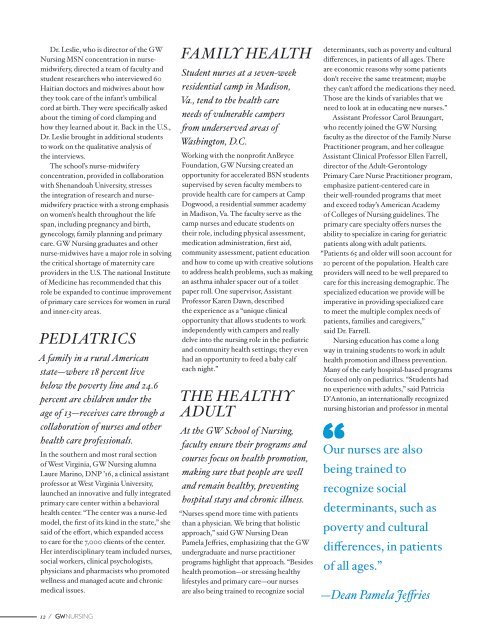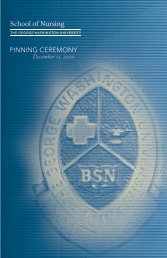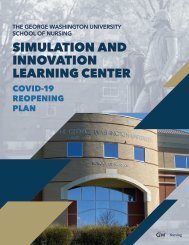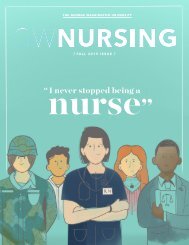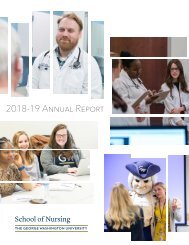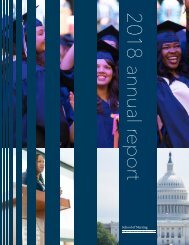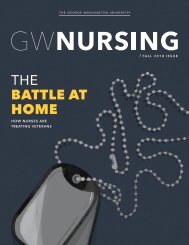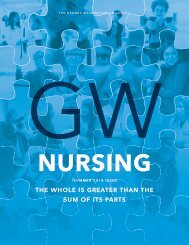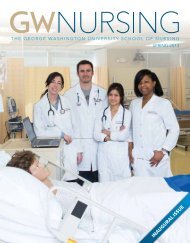GW Nursing Magazine Fall 2017
GW Nursing is a publication of the George Washington University School of Nursing. The magazine tells the story of GW nurses and their endeavors in the areas of education, research, policy and practice.
GW Nursing is a publication of the George Washington University School of Nursing. The magazine tells the story of GW nurses and their endeavors in the areas of education, research, policy and practice.
Create successful ePaper yourself
Turn your PDF publications into a flip-book with our unique Google optimized e-Paper software.
Dr. Leslie, who is director of the <strong>GW</strong><br />
<strong>Nursing</strong> MSN concentration in nursemidwifery,<br />
directed a team of faculty and<br />
student researchers who interviewed 60<br />
Haitian doctors and midwives about how<br />
they took care of the infant’s umbilical<br />
cord at birth. They were specifically asked<br />
about the timing of cord clamping and<br />
how they learned about it. Back in the U.S.,<br />
Dr. Leslie brought in additional students<br />
to work on the qualitative analysis of<br />
the interviews.<br />
The school’s nurse-midwifery<br />
concentration, provided in collaboration<br />
with Shenandoah University, stresses<br />
the integration of research and nursemidwifery<br />
practice with a strong emphasis<br />
on women’s health throughout the life<br />
span, including pregnancy and birth,<br />
gynecology, family planning and primary<br />
care. <strong>GW</strong> <strong>Nursing</strong> graduates and other<br />
nurse-midwives have a major role in solving<br />
the critical shortage of maternity care<br />
providers in the U.S. The national Institute<br />
of Medicine has recommended that this<br />
role be expanded to continue improvement<br />
of primary care services for women in rural<br />
and inner-city areas.<br />
PEDIATRICS<br />
A family in a rural American<br />
state—where 18 percent live<br />
below the poverty line and 24.6<br />
percent are children under the<br />
age of 13—receives care through a<br />
collaboration of nurses and other<br />
health care professionals.<br />
In the southern and most rural section<br />
of West Virginia, <strong>GW</strong> <strong>Nursing</strong> alumna<br />
Laure Marino, DNP ’16, a clinical assistant<br />
professor at West Virginia University,<br />
launched an innovative and fully integrated<br />
primary care center within a behavioral<br />
health center. “The center was a nurse-led<br />
model, the first of its kind in the state,” she<br />
said of the effort, which expanded access<br />
to care for the 7,000 clients of the center.<br />
Her interdisciplinary team included nurses,<br />
social workers, clinical psychologists,<br />
physicians and pharmacists who promoted<br />
wellness and managed acute and chronic<br />
medical issues.<br />
FAMILY HEALTH<br />
Student nurses at a seven-week<br />
residential camp in Madison,<br />
Va., tend to the health care<br />
needs of vulnerable campers<br />
from underserved areas of<br />
Washington, D.C.<br />
Working with the nonprofit AnBryce<br />
Foundation, <strong>GW</strong> <strong>Nursing</strong> created an<br />
opportunity for accelerated BSN students<br />
supervised by seven faculty members to<br />
provide health care for campers at Camp<br />
Dogwood, a residential summer academy<br />
in Madison, Va. The faculty serve as the<br />
camp nurses and educate students on<br />
their role, including physical assessment,<br />
medication administration, first aid,<br />
community assessment, patient education<br />
and how to come up with creative solutions<br />
to address health problems, such as making<br />
an asthma inhaler spacer out of a toilet<br />
paper roll. One supervisor, Assistant<br />
Professor Karen Dawn, described<br />
the experience as a “unique clinical<br />
opportunity that allows students to work<br />
independently with campers and really<br />
delve into the nursing role in the pediatric<br />
and community health settings; they even<br />
had an opportunity to feed a baby calf<br />
each night.”<br />
THE HEALTHY<br />
ADULT<br />
At the <strong>GW</strong> School of <strong>Nursing</strong>,<br />
faculty ensure their programs and<br />
courses focus on health promotion,<br />
making sure that people are well<br />
and remain healthy, preventing<br />
hospital stays and chronic illness.<br />
“Nurses spend more time with patients<br />
than a physician. We bring that holistic<br />
approach,” said <strong>GW</strong> <strong>Nursing</strong> Dean<br />
Pamela Jeffries, emphasizing that the <strong>GW</strong><br />
undergraduate and nurse practitioner<br />
programs highlight that approach. “Besides<br />
health promotion—or stressing healthy<br />
lifestyles and primary care—our nurses<br />
are also being trained to recognize social<br />
determinants, such as poverty and cultural<br />
differences, in patients of all ages. There<br />
are economic reasons why some patients<br />
don’t receive the same treatment; maybe<br />
they can’t afford the medications they need.<br />
Those are the kinds of variables that we<br />
need to look at in educating new nurses.”<br />
Assistant Professor Carol Braungart,<br />
who recently joined the <strong>GW</strong> <strong>Nursing</strong><br />
faculty as the director of the Family Nurse<br />
Practitioner program, and her colleague<br />
Assistant Clinical Professor Ellen Farrell,<br />
director of the Adult-Gerontology<br />
Primary Care Nurse Practitioner program,<br />
emphasize patient-centered care in<br />
their well-rounded programs that meet<br />
and exceed today’s American Academy<br />
of Colleges of <strong>Nursing</strong> guidelines. The<br />
primary care specialty offers nurses the<br />
ability to specialize in caring for geriatric<br />
patients along with adult patients.<br />
“Patients 65 and older will soon account for<br />
20 percent of the population. Health care<br />
providers will need to be well prepared to<br />
care for this increasing demographic. The<br />
specialized education we provide will be<br />
imperative in providing specialized care<br />
to meet the multiple complex needs of<br />
patients, families and caregivers,”<br />
said Dr. Farrell.<br />
<strong>Nursing</strong> education has come a long<br />
way in training students to work in adult<br />
health promotion and illness prevention.<br />
Many of the early hospital-based programs<br />
focused only on pediatrics. “Students had<br />
no experience with adults,” said Patricia<br />
D’Antonio, an internationally recognized<br />
nursing historian and professor in mental<br />
Our nurses are also<br />
being trained to<br />
recognize social<br />
determinants, such as<br />
poverty and cultural<br />
differences, in patients<br />
of all ages.”<br />
—Dean Pamela Jeffries<br />
12 /


